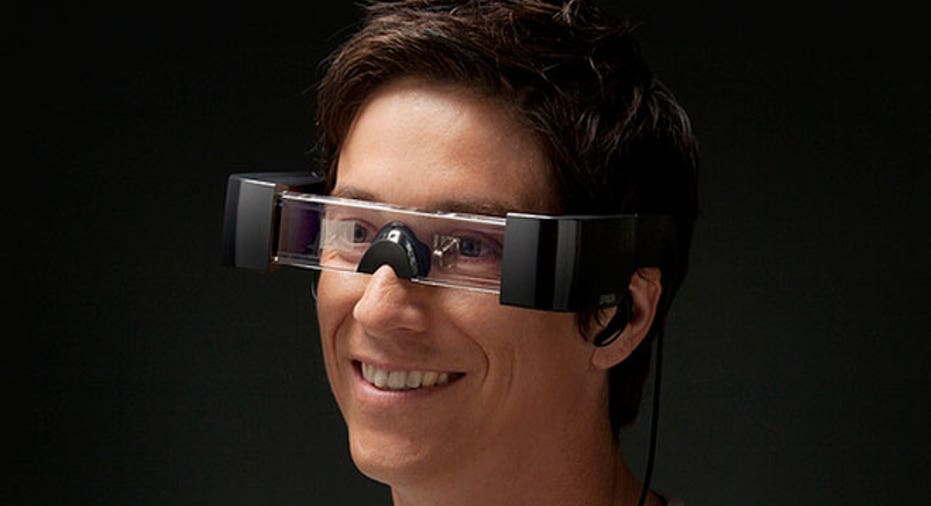Saving Millions by Donning Smart Glasses at Work

Google (NASDAQ:GOOG) may be looking to capture the consumer market with its new smart glasses, but there’s a whole untapped group of corporate customers just waiting to get their hands on a different type of wearable technology in hopes of boosting their bottom lines.
Smart glasses made by Epson, the world’s biggest maker of projectors, with software developed by Apx Labs, are looking to fill this void in the next few years. The companies are testing jointly-developed Android-powered hands-free 3D glasses in hopes it will attract big corporate clients.
The product is being designed to have on-the-job functions, with its offspring potentially changing the way “desk-less” employees operate, says Apx Labs CEO Brian Ballard.
From those working in the warehouses of logistics giants like UPS (NYSE:UPS) and FedEx (NYSE:FDX) to in-stadium entertainment, certain jobs could be “massively augmented with immersive transparent optics,” Ballard said.
The Moverio BT-100 transparent glasses feature micro projectors that create an HD display appearing as an 80-inch image in front of the wearer’s eyes five meters away. It utilizes physical space around them in a way that attaches a ‘digital persona” to objects in space.
Apx has been making similar technology for the military for years, and while the first-generation Moverio has been on the shelves since March, retailing for $699, new generations are expected to be unveiled in the upcoming months and years to meet a “groundswell in demand” for wearable technology.
Reducing the Cognitive Load
Epson and Apx believe a lot of vendors will jump into the heads-up-display and transparent optics markets next year, with production capabilities simultaneously ramping up to get these devices into the hands of consumers and commercial and industrial enterprises. As soon as this fall Apx may announce companies that are integrating the product within their operations.
Picture this: a warehouse employee needs to find a box at a far-off section of the 100,000 square-foot facility. Instead of looking it up on a computer or filing through his brain to determine the direction to take to get there, a map and directions are instantaneously transposed into the physical scene in front of his eyes, feeding him real-time data. Once he arrives, the glasses sense he is holding the package and communicate that back to the corporate system without the worker having to lift a finger from his task at hand.
It might only save a few seconds, but Apx says they will add up over time.
“If you are a big company and you move millions of packages a month you can save tens of millions of dollars,” Ballard said. “We can give a return on investment back in less than a year.”
The Apx technology will eventually be able to communicate with the back-end servers of corporate clients who use Moverio, allowing it to operate seamlessly with internal systems.
“It’s meant to reduce cognitive load on the user,” Ballard said.
Epson’s hardware is different from Google Glass in that it’s meant to be used for a specified amount of time for a particular function, whereas Google’s are intended to be worn all day and really meant to take the place of more traditional mobile devices like tablets and smartphones.
Does This Match My Outfit?
Of course, some significant hiccups remain before devices of this sort can become ubiquitous, including getting over the adoption curve of wearable technology in general and bringing the cost down to a more attractive level.
“It takes a little while before people get used to a new wearable technology,” Ballard said. “You have to create a value why wearing it outweighs your sense of style.”
The developer needs to sell potential customers on why they absolutely have to have it, similar to how Bluetooth makers touted the benefits of the wireless ear piece. The next-generation Moverio will be sleeker, sexier, with corporate-savvy and industrial apps.
“We are starting to see a lot of new innovation in the [wearable tech] space that will drive further increments in the product features/maturity for both upcoming and second and third generations of technology,” Ballard said.
Within five years, Apx Labs sees see-through glasses in “every walk of life,” being able to fit into the ecosystem of virtually every job, particularly those where the employee is up and about.
“It probably won’t replace phones for a very long time, but over the next couple of years, people will get more comfortable” with them, Ballard said.